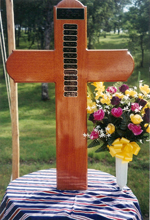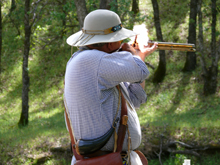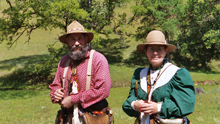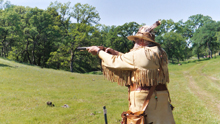History of Rendezvous
Rendezvous (in trapper jargon) was an annual gathering held by a fur trading company at which trappers and mountain men sold their furs and hides and replenished their stocks. Rendezvous were known to be lively, joyous places, whereto all were allowed- free trappers, Indians, native trapper wives and children, travelers and later on, even tourists who would venture from even as far as Europe to observe the festivities. Jim Beckwourth describes: "Mirth, songs, dancing, shouting, trading, running, jumping, singing, racing, target-shooting, yarns, frolic, with all sorts of extravagances that white men or Indians could invent."
* Rocky Mountain Rendezvous, Fred R. Gowans, Gibbs Smith Publisher ISBN 1-58685-756-8
History of black powder rifles, tents, hawks

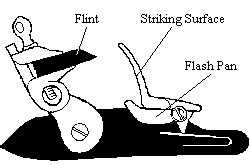
Flintlock is the general term for any firearm based on the flintlock mechanism. The term may also apply to the mechanism. Introduced at the beginning of the 17th century, the flintlock rapidly replaced earlier firearm-ignition technologies, such as the doglock, matchlock and wheellock mechanisms. It continued to be in common use for over two centuries, replaced by percussion cap and, later, cartridge-based systems in the early-to-mid 19th century. Although long superseded by other developments flintlock firearms have enjoyed some popularity with black powder shooting enthusiasts.
French courtier Marin le Bourgeoys made the first firearm incorporating a true flintlock mechanism for King Louis XIII shortly after his accession to the throne in 1610. The development of firearm lock mechanisms had proceeded from matchlock to wheellock to snaplock to snaphance and miquelet in the previous two centuries, and each type had been an improvement, contributing some design features which were useful. Le Bourgeoys fitted these various features together to create the flintlock mechanism. The new system quickly became popular, and was known and used in various forms throughout Europe by 1630. In particular, dragoons serving with the Parliamentarian army in the English Civil War were known to use snaphaunce muskets, or early forms of flintlocks.
Flintlock weapons were commonly used until the mid 1800s, when they were replaced by percussion lock systems. Even though they have long been considered obsolete, flintlock weapons continue to be produced today by manufacturers such as Pedersoli, Euroarms, and Armi Sport. Not only are these weapons used by modern re-enactors, but they are also used for hunting, as many U.S. states have dedicated hunting seasons for black powder weapons, which includes both flintlock and percussion lock weapons.
* Flayderman's Guide to Antique Firearms and Their Values 7th Edition, by Norm Flayderman 1998 Krause Publications ISBN 0-87349-313-3, 9780873493130

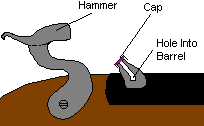
The percussion cap, introduced around 1830, was the crucial invention that enabled muzzle-loading firearms to fire reliably in any weather. Before this development, firearms used flintlock ignition systems which produced flint-on-steel sparks to ignite a pan of priming powder and thereby fire the gun's main powder charge. The flintlock mechanism replaced older ignition systems such as the matchlock and wheellock. Flintlocks were prone to misfire in wet weather, and many flintlock firearms were later converted to the more reliable percussion system. The percussion cap is a small cylinder of copper or brass with one closed end. Inside the closed end is a small amount of a shock-sensitive explosive material such as fulminate of mercury. The percussion cap is placed over a hollow metal "nipple" at the rear end of the gun barrel. Pulling the trigger releases a hammer which strikes the percussion cap and ignites the explosive primer. The flame travels through the hollow nipple to ignite the main powder charge. Percussion caps were, and still are, made in small sizes for pistols and larger sizes for rifles and muskets.
In the 1850s, the percussion cap was first integrated into a metallic cartridge which contained the bullet, powder charge and primer. By the late 1860s, breech-loading metallic cartridges had made the percussion cap system obsolete. Today, reproduction percussion firearms are popular for recreational shooters and percussion caps are still available, though most now use non-corrosive compounds such as lead styphnate.
The percussion cap replaced the flint, the steel "frizzen", and the powder pan of the flint-lock mechanism. It was only generally applied to the British military musket (the Brown Bess) in 1842, a quarter of a century after the invention of percussion powder and after an elaborate government test at Woolwich in 1834. The first percussion firearm produced for the US military was the M1819 Hall rifle.
The discovery of fulminates was made by Edward Charles Howard (1774-1816) in 1800. The invention that made the percussion cap possible using the recently discovered fulminates was patented by the Rev. Alexander John Forsyth of Belhelvie, Aberdeenshire, Scotland in 1807. It consisted of priming with a fulminating powder made of fulminate of mercury, chlorate of potash, sulphur, and charcoal, which was exploded by concussion. It was an invention born of necessity: Rev. Forsyth had noticed that sitting birds would startle when smoke puffed from the powder pan of his flintlock shotgun, giving them sufficient warning to escape the shot. His invention of a fulminate-primed firing mechanism deprived the birds of their early warning system, both by avoiding the initial puff of smoke from the flintlock powder pan, as well as shortening the interval between the trigger pull and the shot leaving the muzzle. Fulminate-primed guns were also less likely to misfire than flintlock guns. However, it was not until after Forsyth's patents expired that the conventional percussion cap system was developed.
Joshua Shaw, an English-born American, is sometimes credited with the development of the first metallic percussion cap in 1814, but his claim remains clouded with controversy as he did not patent the idea until 1822. Shaw’s percussion caps used a mixture of fulminate of mercury, chlorate of potash, and ground glass contained in a small metallic cup. Other possible claimants include François Prélat, who patented the percussion cap in 1818, Joseph Manton, Col. Peter Hawker, and most likely of all, Joseph Egg (nephew of Durs Egg).
* Winant, L. (1956). Early percussion firearms. Bonanza Books
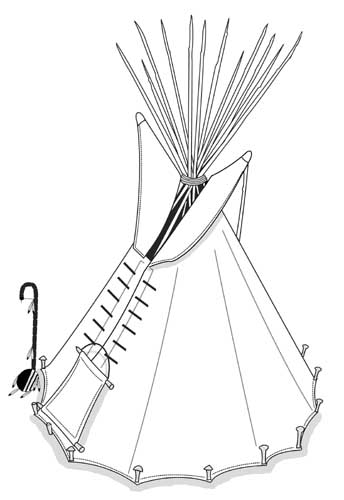
A tipi is a conical tent traditionally made of animal skins or birch bark and popularised by Native Americans of the Great Plains. Tipis are stereotypically associated with Native Americans in general but Native Americans from places other than the Great Plains mostly used different types of dwellings. The term "wigwam" (a domed structure) is sometimes incorrectly used to refer to a tipi. The tipi was durable, provided warmth and comfort in winter, was dry during heavy rains, and was cool in the heat of summer. Tipis could be disassembled and packed away quickly when a tribe decided to move and could be reconstructed quickly when the tribe settled in a new area. This portability was important to Plains Indians with their nomadic lifestyle. Modern tipi covers are usually made of canvas. Contemporary users of tipis include historical reenactors, back-to-the-land devotees, and Native American families attending powwows or encampments who wish to preserve and pass on a part of their heritage and tradition. The word "tipi" comes into English from the Lakota language; the word típi consists of two elements: the verb tí, meaning "to dwell", and a pluralising enclitic (a suffix-like ending that marks the subject of the verb as plural), pi, and means "they dwell". Lakota verbs can be used as nouns and this is the case with típi, which in practice just means "house".
A small fire can be set in the center of the floor of the tipi for heat or cooking. The smoke exits the top of the tipi which is guarded by two adjustable smoke flaps set at right angles to the wind to prevent a downdraft. A draft rising between the cover and the lining adds to the chimney effect and helps carry the smoke up and out. The liner does add insulation in very cold weather when stuffed with grass and can direct the draft upwards and away from the occupants while still admitting fresh air. Air for combustion can be ducted to the fire through a buried pipe when the tipi is closed tightly against inclement weather. In most weather the lining may not be used, and the cover can be rolled up on very hot days a few feet on one or two sides allowing any small breeze to create ventilation.
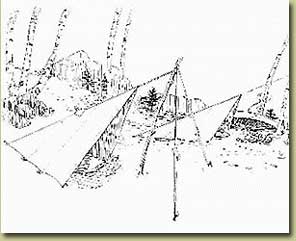
One of the most common shelters in use by the trappers and mountain men was the diamond shelter. This is a shelter created by using a square piece of canvas, staking down three corners of the square, and using a pole to raise the fourth corner up. This allows the user to crawl in, and the shape of the diamond shelter allows for the trapping of heat radiated from the campfire. This is the type of shelter that can be set up and broke down in a very short period of time. Because of that feature, it was used for overnight stays on the trail.
The diamond shelter can, depending on size, accommodate more than one camper. These tents are great for keeping you and your gear reasonably warm and dry in moderately bad weather.
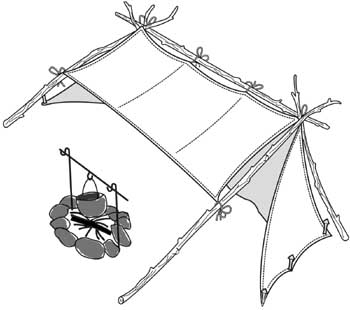
Folks on a budget or who are portraying refugees may want to consider the humble lean-to. Requiring only a single canvas fly, they are very economical, and while they are short on privacy, they provide plenty of shade and shelter from hot sunlight, light rains and morning dew.
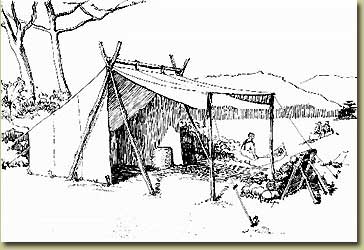
The poor baker tent, no tent has ever had more controversy over whether it is acceptable or not! We won't make Fur Trade and earlier folks happy but we can add information that will dispel the myth that the tent was designed and used for bakers in the first World War. First, tent catalogs and woodsmanship books of the early 20th century contain fine descriptions and drawings. Second, Mr. Henry David Thoreau describes what can only be a Baker in a journal entry he made in 1853. He does not lead one to believe that it is a new style, just a warmer tent than he was using at the time which happened to be a wedge. He explains the name came from it's similarity in appearance to a "Yankee Baker" or, as we call it today, a reflector oven!
The Baker Tent utilizes what looks to be half of a wall tent with an open front that catches the heat off the fire infront of the overhanging flap adding warmth to the tent, similar to a reflector oven's operation. The overhanging flap can be used as shade in the heat, or to cover from the rain. It is also capable of closing down to close off the tent to the outside elements.
* Tentsmiths (2010). Authentic Period Tentage
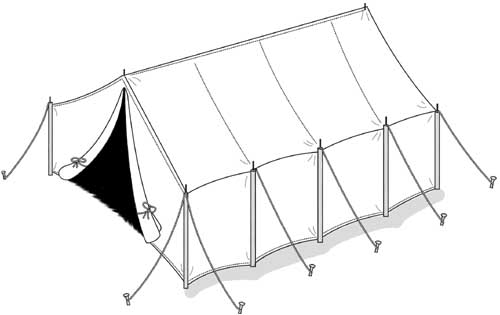
The wall tent was somewhat of a luxury. Usually used for longer encampments, the wall tent was more often used as a general store, saloon, meeting house, or for needs that were more elaborate and less mobile. Setting up a wall tent took some time, and the owners of wall tents were generally better off than a run of the mill refugee or mountain man.
Wall tents have been in use for much longer than at first thought. Paintings from 1544 show open-faced wall tents standing with pavilions and wedges. A model of a tent dated to the mid-17th century, and profusely decorated with taped seams outside and fully embroidered inside, stands in a European museum. There are drawings of wall tents being used in military settings ca. 1740. A sketch brought back from England shows a wall tent with overhanging eaves dating from 1780. Long's expedition of 1819 was recorded in paintings which show the tent in use and numerous other paintings attest to its continued use during the 19th century. Truly a tent that has never gone out of style, the wall tent appears in all the woodsmanship books of the early part of this century.
* CDAML (2007). Organization
* Tentsmiths (2010). Authentic Period Tentage
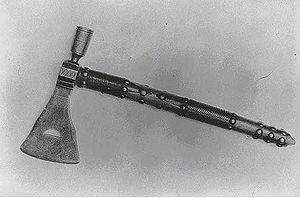
A tomahawk (also referred to as a hawk) is a type of axe native to North America, traditionally resembling a hatchet with a straight shaft. The name came into the English language in the 17th century as a transliteration of the Powhatan (Virginian Algonquian) word. Tomahawks were general purpose tools used by Native Americans and European Colonials alike, and often employed as a hand-to-hand or a thrown weapon, much like the African nzappa zap. It originally featured a stone head, but later iron or brass heads were used. The metal tomahawk heads were originally based on a Royal Navy boarding axe and used as a trade-item with Native Americans for food and other provisions.
The tomahawk shaft is usually less than 2 ft (0.61 m) in length, traditionally made of hickory, ash, or maple. The heads weigh anywhere from 9–20 oz (260–570 g), with a cutting edge usually not much longer than four inches from toe to heel. The poll can feature a small hammer, spike or simply be rounded off, and they usually do not have lugs. Stone tomahawk heads were typically made of polished soapstone, and ornately carved examples were used in some American Indian rituals. These usually had a pipe-bowl carved into the poll, and a hole drilled down the center of the shaft for smoking tobacco through the tomahawk. There are also metal-headed versions of this unusual pipe. Pipe tomahawks are artifacts unique to North America: created by Europeans as trade objects but often exchanged as diplomatic gifts. They are powerful symbols of the choice Europeans and Indians faced whenever they met: one end was the pipe of peace, the other an axe of war.
* Haskew, Mike (2003-09-01). "Pipe Hawks". 30. Blade Magazine. pp. 26–34.

